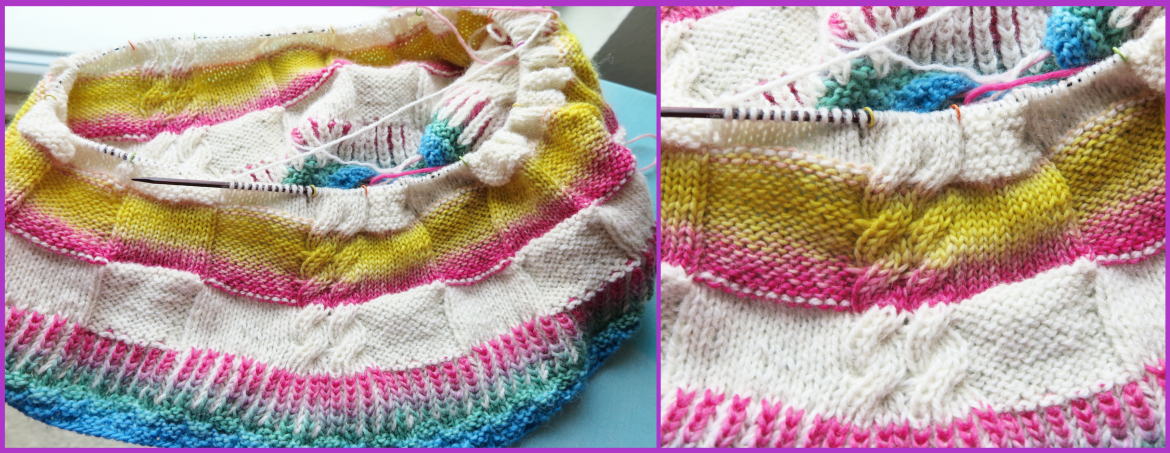Transitioning one color to the next & trouble with purls
I’ve been working on my cowl, and generally have been very happy with how it’s working up. Except one thing:

I didn’t like the way the transition from white to color and back to white looked as I also switched from purl to knit and knit to purl. It wasn’t symmetrical and one side looked extra lumpy. So I had to play around with a little swatch and a couple variations on how I managed the transition. Unfortunately, this also meant pulling back my knitting but I suppose that’s the price of perfection.
I’ve knit it again and I’m much happier now:

There’s no getting around the fact that since I’ve got knit and purl in the pattern, somewhere there will be the little bumps as I go from white yarn to colored yarn, but at least it’s the same going from white to color and color to white now, and I’ve minimized the transition as much as possible.
One thing I can tell you from this process – designing isn’t easy, even when you know exactly what you’re trying to produce. Or maybe especially then? Not sure yet. Anyways, it takes time, attention, and careful thought. Even more so when you are trying to write down what you did so others can repeat the process. I’m developing a great deal of sympathy for scientific researchers who have to take careful note of everything they do so that others can repeat their experiments.
Valuing work
Speaking of work, I think just about anybody who has been knitting, crocheting, spinning or sewing (or any other textile craft) for a significant period of time has encountered at least one person (if not many) who really doesn’t get the time and care that goes into creating something from hand. This ranges from those who are astounded you spent months on a sweater, putting in just a few hours each week, to those who suggest you sell what you make.
With the former, you have to explain why the finished product is “worth it”, whether for you it was enjoyment of the activity itself, or the qualities of fit and materials a custom hand made garment provides. With the latter, it’s a matter of explaining how, once the cost of materials is factored in, you’d either have to charge prices far beyond what most people could afford (or would pay) if you gave yourself even minimum wage, or value your own skilled labor at mere pennies to the hour.
And that would be no way to make a living…
But did you know that that’s how most states expect prison inmates to earn their pocket money for day to day expenses (from tampons to phone cards), to pay medical co-pays and to somehow save up for the day they are released? In some states, inmates work for no money at all. The average for “regular” prison jobs ranges from a low of $0.14/hr to a high of $0.63 per hour per the findings in 2017 by the Prison Policy Initiative.
The Prison Policy Initiative is a non-profit which “produces cutting edge research to expose the broader harm of mass criminalization, and then sparks advocacy campaigns to create a more just society.” In particular, I recommend reading their report “Mass Incarceration: The Whole Pie” which covers the many factors that make up the United States’ systems of confinement. It will provide a better understanding than I can on why one factor, such as low or non-existent prison wages, is one more gross injustice in an unjust system which, among other things, can lock people up for not having enough money in the first place (failing to pay fines/fees, inability to pay bail before trial) and seems designed to ensure repeated failure once they leave prison.
